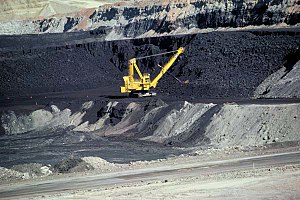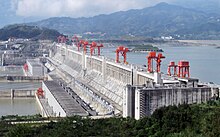Non-renewable resource

A non-renewable resource (also called a finite resource) is a
Conversely, resources such as
Earth minerals and metal ores

Earth minerals and metal ores are examples of non-renewable resources. The metals themselves are present in vast amounts in Earth's crust, and their extraction by humans only occurs where they are concentrated by natural geological processes (such as heat, pressure, organic activity, weathering and other processes) enough to become economically viable to extract. These processes generally take from tens of thousands to millions of years, through plate tectonics, tectonic subsidence and crustal recycling.
The localized deposits of metal ores near the surface which can be extracted economically by humans are non-renewable in human time-frames. There are certain
Fossil fuels
Natural resources such as coal, petroleum(crude oil) and natural gas take thousands of years to form naturally and cannot be replaced as fast as they are being consumed. Eventually it is considered that fossil-based resources will become too costly to harvest and humanity will need to shift its reliance to other sources of energy such as solar or wind power, see renewable energy.
An alternative hypothesis is that carbon based fuel is virtually inexhaustible in human terms, if one includes all sources of carbon-based energy such as methane hydrates on the sea floor, which are vastly greater than all other carbon based fossil fuel resources combined.[2] These sources of carbon are also considered non-renewable, although their rate of formation/replenishment on the sea floor is not known. However their extraction at economically viable costs and rates has yet to be determined.
At present, the main energy source used by humans is non-renewable
The modern-day fossil fuel economy is widely criticized for its lack of renewability, as well as being a contributor to climate change.[3]
Nuclear fuels
In 1987, the
The use of
As of 2013 only a few kilograms (picture available) of uranium have been extracted from the ocean in
Nuclear power provides about 6% of the world's energy and 13–14% of the world's electricity.
Issues entirely separate from the question of the sustainability of nuclear fuel, relate to the use of nuclear fuel and the high-level radioactive waste the nuclear industry generates that if not properly contained, is
Land surface
Land surface can be considered both renewable and non-renewable resource depending on the scope of comparison.
Renewable resources

The production of goods and services by
In the natural environment water, forests, plants and animals are all renewable resources, as long as they are adequately monitored, protected and conserved. Sustainable agriculture is the cultivation of plant and animal materials in a manner that preserves plant and animal ecosystems and that can improve soil health and soil fertility over the long term. The overfishing of the oceans is one example of where an industry practice or method can threaten an ecosystem, endanger species and possibly even determine whether or not a fishery is sustainable for use by humans. An unregulated industry practice or method can lead to a complete resource depletion.[23]
The renewable energy from the sun, wind, wave, biomass and geothermal energies are based on renewable resources. Renewable resources such as the movement of water (hydropower, tidal power and wave power), wind and radiant energy from geothermal heat (used for geothermal power) and solar energy (used for solar power) are practically infinite and cannot be depleted, unlike their non-renewable counterparts, which are likely to run out if not used sparingly.
The potential wave energy on coastlines can provide 1/5 of world demand. Hydroelectric power can supply 1/3 of our total energy global needs. Geothermal energy can provide 1.5 more times the energy we need. There is enough wind to power the planet 30 times over, wind power could power all of humanity's needs alone. Solar currently supplies only 0.1% of our world energy needs, but there is enough out there to power humanity's needs 4,000 times over, the entire global projected energy demand by 2050.[24][25]
Renewable energy and energy efficiency are no longer niche sectors that are promoted only by governments and environmentalists. The increasing levels of investment and that more of the capital is from conventional financial actors, both suggest that sustainable energy has become mainstream and the future of energy production, as non-renewable resources decline. This is reinforced by climate change concerns, nuclear dangers and accumulating radioactive waste, high oil prices, peak oil and increasing government support for renewable energy. These factors are commercializing renewable energy, enlarging the market and growing demand, the adoption of new products to replace obsolete technology and the conversion of existing infrastructure to a renewable standard.[26]
Economic models
In economics, a non-renewable resource is defined as
See also
References
- OCLC 846463785.
- ^ "Methane hydrates". Worldoceanreview.com. Retrieved 17 January 2017.
- ISBN 978-0-309-14588-6.
- ^ Rössing (from infomine.com, status Friday 30 September 2005)
- U.S. Geological Survey (October 1997). "Radioactive Elements in Coal and Fly Ash: Abundance, Forms, and Environmental Significance"(PDF). U.S. Geological Survey Fact Sheet FS-163-97.
- ^ "Coal Combustion – ORNL Review Vol. 26, No. 3&4, 1993". Archived from the original on 5 February 2007.
- ^ Brundtland, Gro Harlem (20 March 1987). "Chapter 7: Energy: Choices for Environment and Development". Our Common Future: Report of the World Commission on Environment and Development. Oslo. Retrieved 27 March 2013.
Today's primary sources of energy are mainly non-renewable: natural gas, oil, coal, peat, and conventional nuclear power. There are also renewable sources, including wood, plants, dung, falling water, geothermal sources, solar, tidal, wind, and wave energy, as well as human and animal muscle-power. Nuclear reactors that produce their own fuel ("breeders") and eventually fusion reactors are also in this category
- ^ American Petroleum Institute. "Key Characteristics of Nonrenewable Resources". Retrieved 21 February 2010.
- ^ http://www.epa.gov/radiation/tenorm/geothermal.html Geothermal Energy Production Waste.
- ^ "World Uranium Mining". World Nuclear Association. Retrieved 28 February 2011.
- ^ "What is uranium? How does it work?". World Nuclear Association. Retrieved 28 February 2011.
- ^ "The current state of promising research into extraction of uranium from seawater – Utilization of Japan's plentiful seas: Global Energy Policy Research". gepr.org.
- .
- ^ World Nuclear Association. Another drop in nuclear generation Archived 7 January 2014 at the Wayback Machine World Nuclear News, 5 May 2010.
- ^ "Factsheets & FAQs". International Atomic Energy Agency (IAEA). Archived from the original on 25 January 2012. Retrieved 1 February 2012.
- ^ United Nations Scientific Committee on the Effects of Atomic Radiation. Sources and Effects of Ionizing Radiation, UNSCEAR 2008
- ^ Mcclain, D.E.; A.C. Miller; J.F. Kalinich (20 December 2007). "Status of Health Concerns about Military Use of Depleted Uranium and Surrogate Metals in Armor-Penetrating Munitions" (PDF). NATO. Archived from the original (PDF) on 7 February 2012. Retrieved 1 February 2012.
- ^ AJ González (2000). "The Safety of Radioactive Waste Management" (PDF). IAEA.
- ^ J.Singh (17 April 2014). "Land: Meaning, Significance, Land as Renewable and Non-Renewal Resource". Economics Discussion. Retrieved 21 June 2020.
- ISSN 2211-9124.
- ^ "重庆云阳长江右岸现360万方滑坡险情-地方-人民网". People's Daily. Retrieved 1 August 2009. See also: "探访三峡库区云阳故陵滑坡险情". News.xinhuanet.com. Retrieved 1 August 2009.
- ^ Lin Yang (12 October 2007). "China's Three Gorges Dam Under Fire". Time. Retrieved 28 March 2009.
The giant Three Gorges Dam across China's Yangtze River has been mired in controversy ever since it was first proposed
See also: Laris, Michael (17 August 1998). "Untamed Waterways Kill Thousands Yearly". The Washington Post. Retrieved 28 March 2009.Officials now use the deadly history of the Yangtze, China's longest river, to justify the country's riskiest and most controversial infrastructure project – the enormous Three Gorges Dam.
and Grant, Stan (18 June 2005). "Global Challenges: Ecological and Technological Advances Around the World". CNN. Retrieved 28 March 2009.China's engineering marvel is unleashing a torrent of criticism. [...] When it comes to global challenges, few are greater or more controversial than the construction of the massive Three Gorges Dam in Central China.
and Gerin, Roseanne (11 December 2008). "Rolling on a River". Beijing Review. Archived from the original on 22 September 2009. Retrieved 28 March 2009...the 180-billion yuan ($26.3 billion) Three Gorges Dam project has been highly contentious.
- ^ "Illegal, Unreported and Unregulated Fishing in Small-Scale Marine and Inland Capture Fisharies". Food and Agriculture Organization. Retrieved 4 February 2012.
- ^ R. Eisenberg and D. Nocera, "Preface: Overview of the Forum on Solar and Renewable Energy," Inorg. Chem. 44, 6799 (2007).
- ^ P. V. Kamat, "Meeting the Clean Energy Demand: Nanostructure Architectures for Solar Energy Conversion," J. Phys. Chem. C 111, 2834 (2007).
- ^ "Global Trends in Sustainable Energy Investment 2007: Analysis of Trends and Issues in the Financing of Renewable Energy and Energy Efficiency in OECD and Developing Countries (PDF), p. 3" (PDF). United Nations Environment Programme. Retrieved 4 March 2014.
- ^ Cremer and Salehi-Isfahani 1991:18
- S2CID 44026808.
- JSTOR 1828079.
